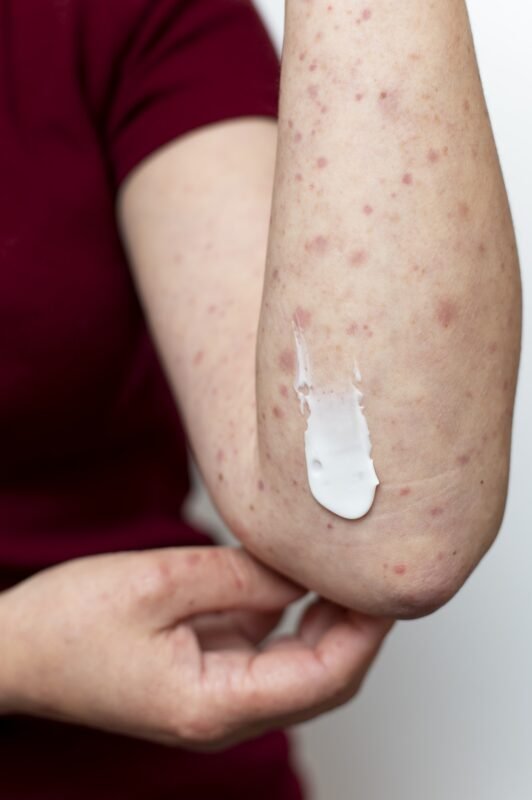Skin Care Health
Everyday Exposure: The Quiet Culprits Behind Irritated Skin
Understanding Contact Dermatitis and Common Skin Irritants
If you have sensitive skin, you’re probably familiar with the frustration of trying a new soap or cosmetic—only to end up with redness, itching, or a burning sensation. But it’s not just beauty products that can cause trouble. Everyday items in your home may also harbor hidden skin irritants, including triple-antibiotic ointments, adhesive bandages, fragrances, household cleaners, and even jewelry containing metals like nickel. When your skin reacts to one of these substances, the condition is known as contact dermatitis—an inflammatory skin response triggered by direct exposure to an irritant or allergen.
Types of Contact Dermatitis
There are two primary types of contact dermatitis: irritant contact dermatitis and allergic contact dermatitis.
Irritant Contact Dermatitis
This is the most common form, responsible for approximately 80% of all contact dermatitis cases. It occurs when the skin’s outer layer is damaged by repeated exposure to a substance, resulting in a reaction that often resembles a burn. Symptoms typically include red, dry, chapped skin that may crack or blister. Unlike allergic reactions, this type of dermatitis tends to be more painful than itchy.
Common irritants include:
- Strong soaps and detergents
- Drain cleaners
- Acids
- Acetone (found in nail polish removers)
- Alcohol-based hand sanitizers (especially with increased use during COVID)
- Household cleaning agents
- Certain plants and fertilizers
Sensitivity to irritants can vary from person to person. Some people develop reactions from even mild products if used frequently or without proper skin protection. Repeated contact with cleaning supplies, for example, can slowly erode the skin’s protective barrier, making it more vulnerable to irritant dermatitis.
Typical symptoms include:
- Dry, cracked, or scaly skin
- Mild swelling or inflammation
- Redness and stinging or burning sensations
- Blisters or even small, painful ulcers
- A feeling of tightness or stiffness in the affected area
Chemical Skin Irritants
Many of the harshest chemical irritants are labeled with clear warnings such as “DANGER,” “POISON,” or “USE IN A WELL-VENTILATED AREA.” These advisories aren’t just for inhalation risks—they’re also meant to protect your skin. Common culprits include:
- Ammonia and ammonium hydroxide
- Chloride compounds (like bleach)
- Phenol
- Petroleum solvents and distillates
- Sodium bisulfate and other acidic agents
Despite these labels, it’s easy to underestimate the damage these products can do with repeated, unprotected contact. Over time, even brief exposure can lead to cumulative damage, especially if your skin is already compromised or sensitive.
Other Common Skin Irritants
Many things around your household can irritate skin.
Soap
A lot of hand washing with soap and water strips the skin of its natural oils. This can cause “dishpan hands.” At first, your skin may look dry and chapped. But if it lasts a long time and is not treated, your skin can crack and bleed.
Dishwashing soap, bubble bath, and body washes might also have this effect.
Fabric dryer sheets
Fabric softener and dryer sheets can cause itchy, irritant reactions.
If you see rashes in places that are covered by clothing and relative sparing where the clothing is not, that’s a big giveaway.
Heat
Hot weather – especially during summer months – can make skin problems related to sweating flare up. You might notice redness or chafing in certain areas, like the underarms, belly folds, and groin.
Latex
Some people are very sensitive to latex, a natural rubber found in everything from gloves to condoms. If you are sensitive to latex, you may get welts under a bra strap or elastic waistband. Also, some people who are allergic to latex may have reactions to some tropical fruits such as avocados, bananas, and kiwis. That’s because the fruits have proteins that are like those in latex. This condition is called “latex-fruit syndrome.”
Fragrances
Fragrance allergies are really common. But there are about 5,000 fragrances that use many different combinations, so it may be tricky to find out the offending chemical. Some people might develop a skin rash or hives from musk, while others react to vanilla scents.
Facial creams
The skin on your face, with its deep pores, is easily affected. So it makes sense to take extra care with your creams and skin care products if you have stinging or burning when you put it on. These products may include wrinkle creams, cleansers, and skin peels.
Check the labels for some common irritants paraben preservatives.
Plants
Poison ivy, poison oak, and poison sumac are three of the most common causes of allergic contact dermatitis in the U.S. They all contain an oil called urushiol, which triggers an allergic reaction, usually an itchy rash.
A mild reaction might last 5 to 12 days. A more serious reaction can last 30 days or even longer. Most people don’t come into contact with poison ivy, oak, or sumac on purpose. But you need to learn how to spot them to avoid contact.
Food
Food allergies can cause skin reactions from hives to rashes. But you don’t have to eat the foods – even handling them can irritate your skin. If you happen to have cuts or cracks on your hands – even tiny ones you can’t see – handling acidic foods or spices can be irritating.
Nickel
Nickel can be found in costume jewelry, watchbands, zippers, and other everyday items. If you have serious allergies, it’s possible to even have reactions to vitamins and the hardware used to repair a broken limb.
Sunscreen
Of course, doctors recommend you use sunscreen to protect your skin from harmful UVA and UVB radiation. But certain chemicals in sunscreens can cause a rash or allergic reaction. The most common reactions happen with sunscreens that have PABA-based chemicals. So you may want to find a PABA-free alternative if you get an allergy.
A Skincare Brand is Born
To toot my own horn for a moment—this is one of the core reasons I started Luxe Body Worx. I wanted to create skincare that returns to nature: products inspired by natural ingredients, free from harsh or toxic chemicals, and genuinely effective. I spend countless hours researching—not through casual web searches, but through medical journals, peer-reviewed studies, and trusted scientific texts—to find the right ingredients for the right formulations. Because it matters. I’m deeply passionate about the transformative power of our brand—because I’ve seen firsthand how our products make a meaningful difference in people’s skin and confidence.
My Personal Experience
During a humanitarian mission in Central America, I was deployed as the Medical Planner and spent about 100 days in-country. Due to limited personnel and funding, everyone—regardless of rank—was responsible for cleaning duties. We rotated tasks, and during my turn, I noticed the palms of my hands were splotchy and slightly inflamed. I didn’t think much of it at first. But the next time I cleaned, my hands were unmistakably red, irritated, and inflamed—even though I had worn gloves.
Curious, I read the fine print on the glove box and found the words “semi-permeable.” Who manufactures semi-permeable gloves??
My visit to the Troop Medical Clinic (TMC) turned into an unexpected training opportunity for the combat medics. The physician issued a permanent profile exempting me from cleaning duties for the remainder of the deployment. Whatever harsh ingredient was in the cleaning agents had clearly reacted with my body chemistry.
With limited medical supplies, one of the medics crushed Benadryl tablets and mixed them into a calamine cream, which I applied before dawning cloth gloves. The itching was relentless, and it took 7 to 10 days for the reaction to subside.
The thing about contact dermatitis is this: with each subsequent exposure, the reaction tends to intensify—often becoming more severe every time.
To Conclude
Contact dermatitis isn’t just uncomfortable—it can interfere with daily life and potentially lead to chronic skin issues if not managed properly. The key to prevention is awareness: know what’s in the products you use, wear protective gloves when handling irritants, and always moisturize to help maintain your skin’s natural barrier. If you suspect a product is causing irritation, discontinue use and consult with a healthcare provider. Early identification and proactive care are essential to keeping your skin healthy, strong, and resilient. ![]()

